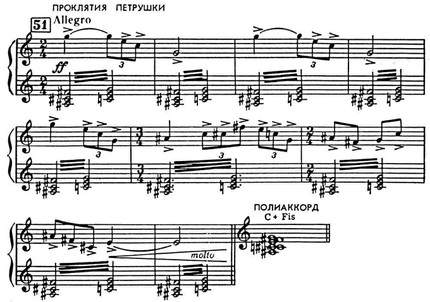
Polychord |
from the Greek polus – many, numerous, extensive and chord
A chord of a complex (composite) structure, i.e. polyphony, stratified into relatively independent. parts or folding of two or several. relatively independent. chord parts.

I. F. Stravinsky. “Parsley”, 2nd painting.
P. has the form of two or more. dec. according to the sound composition of chords sounding simultaneously.
Parts of P. called. subchords (here 2 subchords – C-dur and Fis-dur). One of the subchords (often the lower one) in most cases forms the core (or basis) of P., and the main. the tone of such a subchord becomes basic. the tone of the entire consonance (S. S. Prokofiev, side theme of the 1st part of the 9th sonata for piano: G-dur – core, h-moll – layering). P. is often formed in “layer (chord) polyphony” – a fabric where each “voice” (more precisely, layer) is represented by a (sub)chord succession (A. Honegger, 5th symphony, 1st movement).
Express. P.’s properties are associated with the perception of two or more. non-identical chords in simultaneity; at the same time, the main thing (as in other composite structures) is not in the sound of each of the subchords, but in the new quality that arises when they are combined (for example, in the musical example C-dur and Fis-dur are consonant chords, and the whole is dissonance; subchords are diatonic, P. is non-diatonic; the major character of each of the subchords expresses light and joy, and P. – “curses” of Petrushka, then – “despair” of Petrushka). The term “P.” introduced by G. Cowell (1930).
References: see under article Polyharmony.
Yu. N. Kholopov



